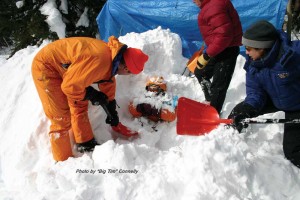While the main focus of the week is going to be on gear, this is also going to be an opportunity to showcase something that might benefit everyone of us in dealing with our arch enemy, the avalanche lizard.
On January 21st, during the On-Snow Demo at Solitude ski resort, I will be hosting “Can You Dig It?” a shoveling competition to draw attention to the dirty deed — digging — each of us might someday be expected to perform flawlessly. Woe to those who need to, but don’t.
As a community backcountry skiers have done a remarkable job of looking out for each other and encouraging everyone to be avy savvy. Newbies are encouraged to take an avalanche course, and a refresher never hurts, even for experts. Avalanche beacons have been developed to the point where they really do help you find signals, multiple ones even, with admittedly little practice. The latest addition to our arsenal of avalanche safety equipment, packs that, if caught, can improve your odds of staying on top, and alive, dramatically. All good stuff but none of it is fool-proof.
More importantly there’s a gap in the game of avalanche preparedness. In the event that you’re involved in an avalanche rescue it may come down to actually digging someone out to save them. Are you prepared? Not just in finding a beacon, but in excavating somebody who is buried, and not just beneath the surface.
To raise awareness of the need to practice this critical phase of avalanche rescue “Can You Dig It?” is a shoveling race that will pit five manufacturers against each other to show the importance of teamwork, strategy, tools, and muscle. Five 3-man teams will view for bragging rights and the opportunity to show off the best way to dig, and the best tools for excavating a buried avalanche victim.The competition begins at 1pm and promises to be a fun spectator event and learning experience for all.
Some details worth noting. The competition will be held near where Solitude’s Beacon Basin has been staged the past few years. There are five shovel manufacturers hoping to demonstrate the superiority of their shovels, as well as a trick or two in shoveling techniques.
Rules of Engagement
- Each dummy will be buried in a similar position, approximately 1–1½ meters beneath the surface. All teams agreed to a burial depth of 1.5 meters, but there may not be enough snow to achieve that consistently.
- The total age of each team must be at least 105. This should effectively prevent teams from being seeded with all 20-year-olds.
- The location of each dummy will be identified with an avalanche probe before the race begins. The objective is to demonstrate proficiency with digging, not searching where to dig, but how to dig.
- First team to completely extract their dummy wins.
It is my expectation that this competition will highlight differences in shoveling strategies, and in the tools used.
The five teams will be shoveling on behalf of, and using the shovels manufactured by: Arva, Backcountry Access, Black Diamond, Cascade Designs, and Ortovox.
Each team will provide a videographer to document their team’s strategy and tools. These videos may be used to help educate the general public on shoveling strategies and recommended tools for and avalanche rescue.
Hopefully this sort of race will become adopted as a way to prepare for an avalanche rescue by backcountry aficionados, at least those taking/teaching coursed in avalanche education.
Related Posts
Canadian study reduces avalanche survival time
Buried Alive
Shoveling Strategy
© 2014



Recent Comments